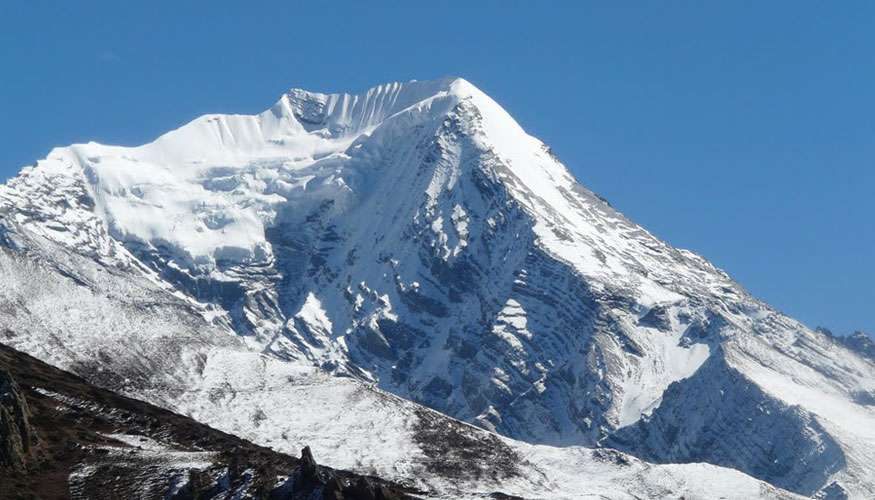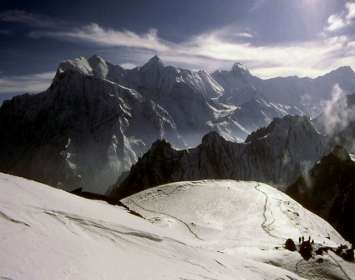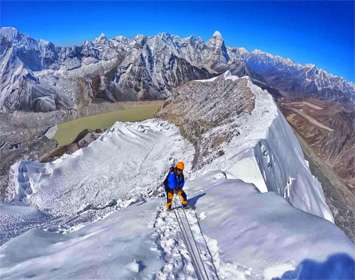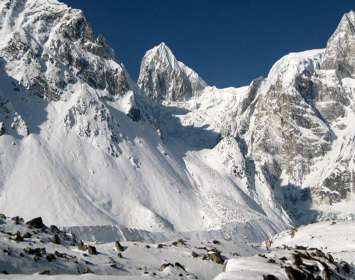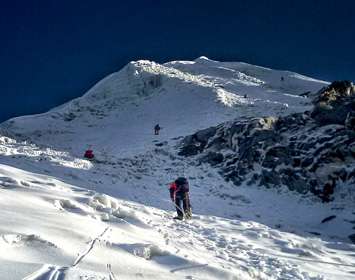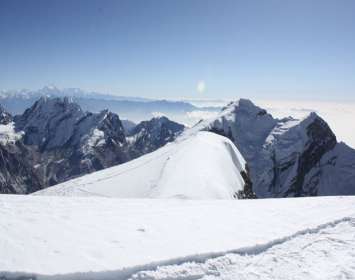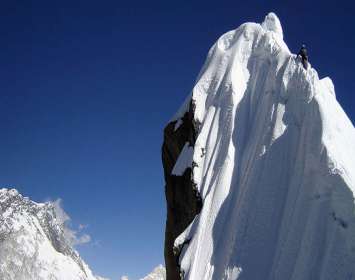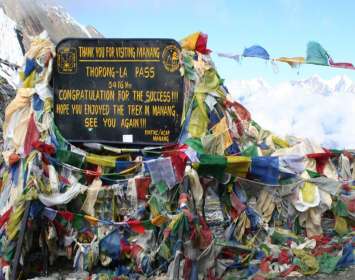Good to Know
Pisang Peak Climbing route
Pisang Peak Climbing begins with a long scenic drive from Kathmandu to Dharapani. From here, you will gradually ascend through lush forests and small villages like Chame & Upper Pisang to Pisang Peak Base Camp. From the base camp, you will ascend along the south-west ridge and towards the High Camp and move up to the Pisang Peak Summit. The trail drops down to Manang Valley and passing through Yak Kharak, you climb to Thorong La Pass. Further, the trail descends to Muktinath and move along the Kali Gandaki River and lovely apple orchards to Jomsom.
Best time to go Pisang Peak Climbing
Spring i.e. March to May is the best time to go on Pisang Peak Climbing. These months are mostly preferred by the climbers to do high climbing in the Himalayas because the weather remains mostly stable throughout the day. Likewise, the bright blue sky and stunning views of snow-capped makes the journey more thrilling.
Another very good time to go on Pisang Peak Climbing 18 Days is during the Autumn (October to November). Again, the weather is mostly stable and moderate climate, however you will feel slight chilliness during the day time.
Pisang Peak Climbing difficulty
Pisang Peak Climbing is a difficult journey. You will not only ascend to the summit of Pisang Peak but also cross one of the most challenging passes of Nepal, Thorong La Pass. The trail is steep, rugged, and snowy. Before reaching the summit, you have to overcome hanging glaciers and huge rock slabs. You have to walk 6 to 7 hours a day. All of these demands good health, strong physical fitness, determination, and commitment.
Altitude Sickness Symptoms & Prevention
Along with trekking, you also have to care about altitude sickness. We have designed our Pisang Peak Climbing itinerary including adequate numbers of rest days to make sure you do not have to face high altitude sickness. It is also known as Acute Mountain Sickness (AMS) that usually happens during a high altitude journey.
Below you can read about symptoms and preventive measures of altitude sickness:
Symptoms of altitude sickness:-
- headache
- nausea and vomiting
- dizziness
- tiredness
- loss of appetite
- shortness of breath
- Preventive measures of altitude sickness:-
- Include an adequate number of rest days during the trek/climbing
- Avoid climbing more than 300-500 meters a day
- Make sure you're drinking enough water
- Eat a light but high-calorie diet
- Avoid alcohol
- Avoid smoking
- Inform your guide immediately so that he can take proper action on time
- Drop down to lower altitude and rest for a few days until symptoms getaway
Food & Water during Pisang Peak Climbing
When you will stay in the teahouse, the meals will be served as per their menu. It is a kind of culture in high altitude villages that you eat meals in the same place you stay overnight. Villages at low altitudes have more varieties of dishes comparison to high altitude villages. You can get dishes like dal bhat, veggies, curries, eggs, chapati, bread, porridge, sandwich, dumplings, pasta, rice pudding, etc.
During camping, the food will be cooked by our expert crew members. We will serve a good variety of meals, which are nutritious and full of energy to keep you going. You can refill your water bottle every time it gets empty in the teahouse. They give boiled water. Buying a plastic water bottle is way more expensive and not good for the environment. Also, carry water purification tablets with you for extra safety.
Accommodation during Pisang Peak Climbing
Teahouse will be the main accommodation of our during Pisang Peak Climbing. The rooms generally come with two single beds, which means you have to share it with another trekker. If you want a single room, the cost will get double. Make sure to carry the nice quality of sleeping bag as the rooms up there are not insulated, and it can get very cold during the night. Talking about washrooms, there are more chances of a common washroom then private, especially in the higher altitude.
Pisang Peak Climbing permit
To go on Pisang Peak Climbing, you need to get three permits that are Pisang Peak Climbing Permit, Annapurna Conservation Area Permit, and TIMS Card. You can get in touch with us to know more about the permits and documents.
Spring (March to May)- USD 250
Autumn (September to November)- USD 125
Winter (December to February)- USD 70
Summer (June to August)- USD 70
Pisang Peak Climbing cost
There are so many factors that increases or decreases the cost of the package. Regardless of all the circumstances, we promise you to provide the best price and high-quality service in the market. Check our const include and exclude part for more information, or feel free to get in touch with us.
Environmental Practices
We run eco-friendly tours and treks to preserve the environment. All our gear and equipment are also environmentally friendly. Along with that, we also promote eco-friendly tourism and advise our guests to use reusable products on the trail. Likewise, we are also involved in promoting and uplifting locals and their lifestyle. With us, you will be traveling carefully.
Pisang Peak Climbing Packing List
We want you to know that you can rent or buy all the gears in Kathmandu. There are several options from medium range brands to high-end brands for all budget types.
- Clothing
- Sun hat/scarf
- Fleece jacket with wind-Stopper
- Waterproof shell jacket
- Down vest and/or jacket
- Lightweight gloves/Heavyweight gloves or mittens with a waterproof shell outer
- Light and expedition weight thermal bottoms
- Fleece/wool pants
- Waterproof (preferably breathable fabric) shell pants
- Thick, warm wool hiking socks
- Hiking boots with spare laces
- Sunglasses with UV protection
Accessories
- Sleeping bag rated to zero degrees Fahrenheit
- Trekking poles
- Headlamp
- Trek bag-pack
- Basic First Aid Kit
- Daypack
- Thermo-rest sleeping pad
- Water bottles
Climbing gears
- Climbing harness
- Ice ax
- crampons
- Mountaineering boots
- AscenderDescender/Abseil device
- Rope
- Snow bar
- Ice hammer
- Helmet (optional)
Toiletries
- Quick-drying towel/Small wash towel
- Soap (biodegradable)
- Toothbrush/paste biodegradable)
- Deodorants
- Face and body moisturizer
- Nail clippers
- Small mirror
- Tissue paper/toilet roll
- Anti-bacterial Hand wash
Extra
- Trail Map/Guide book
- Binocular
- Reading book
- Journal & Pen
- Pencils and small notebooks
- Camera with extra batteries

